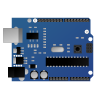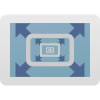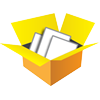Open Exhibits was an initiative, originally funded by the National Science Foundation, that looked to transform the way in which museums and other informal learning institutions produce and share digital exhibits. Open Exhibits was both a collection of software and a community of practice. In September of 2014, the Institute of Museum and Library Services funded a new project, Omeka Everywhere, which tied Open Exhibits to Omeka, an open source web publishing platform for the display of museum and library collections. In December 2018, the project was officially completed and is now archived. Please contact Ideum if you have questions about the Open Exhibits Initiative.
The Software
Open Exhibits focuses on the development of new human computer interaction (HCI) exhibits that create physically engaging and socially interactive visitor experiences. The Open Exhibits software collection includes templates, components, and utilities that serve as building blocks for creating digital exhibits and interactives. These tools facilitate the development of applications that encourage shared-surface, collaborative computing and other HCI innovations.
Open Exhibits introduced the Creative Markup Language (CML) for rapidly assembling exhibits through XML, HTML, and CSS. This enables non-programmers to create HCI-driven applications that extend beyond the HTML5 model. Open Exhibits also has its own powerful software development kit (SDK) in ActionScript that can be used to interface with a CML-driven applications or create custom CML components. The CML library is open source under the simplified BSD license.
The Open Exhibits SDK includes a gesture analysis engine and Gesture Markup Language (GML) library. This enables museums to create innovative gesture-driven exhibits without needing to program gestures or object transformations. Gestures can be enabled and modified through GML, and triggered through a variety of input devices including touch screens, Leap Motion Controller, Microsoft Kinect, TUIO, and more. The GML library is closed source, but has been made freely available through the Open Exhibits initiative.
In 2013, Open Exhibits partnered with the Away Foundation. Away3D supplies the rendering framework for the latest 3D capabilities of the Open Exhibits software platform, integrating with a specifically designed 3D CML extension and GestureWorks own 3D gesture support. The update offers new ways for Open Exhibits users to engage their audience with interactive 3D content.
In 2014, Open Exhibits began a partnership with The Roy Rosenzweig Center for History and New Media at George Mason University and the University of Connecticut’s Digital Media Center. The Institute of Museum and Library Sciences (IMLS) awarded our organizations a National Leadership Grant for Museums to connect Open Exhibits with Omeka.
Open Exhibits software and SDK is available free to museums, libraries, students, schools, nonprofits, and U.S. government agencies. The software may also be used for commercial entities but some restrictions apply. Please reference the legal for more details.
The Community of Practice
Along with making software available to the community, Open Exhibits is involved in community outreach through the Open Exhibits website, workshops, lectures, and other initiatives.
The Open Exhibits website is a place to learn about emerging technologies and effective practices in exhibit development. The Blog and Research sections of the site highlight projects created with Open Exhibits, point to papers and research, highlight new technologies, and show off DIY hardware projects. We encourage our members to contribute in these areas and others.
Other initiatives include the Creating Museum Media for Everyone (CMME) accessibility initiative and the Human Computer Interaction in Informal Science Education (HCI + ISE) conference.
CMME aims to further the museum and library field’s understanding of ways to research, develop, and evaluate digital interactives that are inclusive of all people. CMME includes a do-it-yourself digital toolbox and guidelines for creating inclusive exhibits. Included in the toolbox as of February 2015 will be an extension to the Open Exhibits SDK that will enable developers to create a multitouch accessibility layer for the visually impaired.
The HCI+ISE conference took place in Albuquerque, NM June 11-14, 2013. Over fifty invited participants from the fields of exhibit design, science education, technology, and museums gathered to discuss and speculate on the direction of human computer interaction in informal science education settings. The participant driven conference featured a day of pre-conference workshops, provocations, open discussions, interest groups, technology showcases, and tours of local museums and science centers. A record of the proceedings can be found in the Open Exhibits Papers section.
Open Exhibits is operated by Ideum, a software and hardware firm with deep roots in the informal education field. We work with a number of partners and advisors on Open Exhibits. Feel free to contact us if you have comments, questions, or want to become more involved in the project.
Project History
Open Exhibits received funding in September of 2010. The first community-based website launched just two months later in mid-November of 2010. Since then, the site has grown with thousands of members and tens of thousands of software downloads. Below is a timeline of project highlights.
September 2010, Open Exhibits received NSF funding.
November – December 2010, Open Exhibits core software, Gesture Library & Illustrations, and website created.
January 2011, Gigapixel Viewer and MT-Kinect modules released.
March 2011, Open Exhibits held a Design Summit exploring multitouch and motion-recognition technologies and the exhibit design challenges that these new technologies present.
March 2011, Collaboration between SENSUS and Open Exhibits software initiative.
April 2011, Open Exhibits Bootcamp at Museums and the Web 2011.
June 2011, Open Exhibits SDK 1.6 released.
June 2011, Design Summit summary document released.
October 2011, Open Exhibits participates in panel discussion on ‘Innovative Collaborative Development and Sharing of Education Resources’ at the ASTC conference.
October 2011, Refined designs for the Collection Viewer unveiled.
October 2011, Heist! project looking for museum testers.
November 2011, Release of new Kinect-based software; Open Exhibits Kinect and Gigapixel software appear in exhibit at the Tech Museum of Innovation, San Jose, CA.
November 2011, Open Exhibits and Heist! demonstration at the Samsung Digital Discovery Center at the British Museum, London.
December 2011, Open Exhibits Year One evaluation report completed.
February 2012, Open Exhibits SDK used in creating ’100 Years of State & Federal Policy’ exhibit at the Indian Pueblo Cultural Center, Albuquerque, NM.
March 2012, Open Exhibits 2.0 released; introduction of Creative Markup Language; new software components and exhibit templates.
April 2012, Open Exhibits 2.0.1 released with new components: Mask Image Viewer, Panoramic Viewer, and Media Viewer.
April 2012, Papers section of the Open Exhibits website updated.
May 2012, Creating Museum Media for Everyone (CMME) workshops at the Museum of Science, Boston.
August 2012, Papers section of the Open Exhibits site expanded with search function and tagging.
September 2012, Human Computer Interaction in Informal Science Education (HCI+ISE) conference funded by the National Science Foundation.
October 2012, Open Exhibits 2.5 released; Orb Menu UI element; Tabbed Container UI element; Touch Keyboard UI element; new layout system.
March 2013, Flickr Collection Viewer released.
April 2013, Collection Viewer is paired with CollectiveAccess collection management software.
April 2013, Open Exhibits 2.6 released; 2D Leap integration; Starling support; new and improved UI elements and components.
April 2013, Open Exhibits workshop at Museums and the Web 2013.
May 2013, Open Exhibits at American Alliance of Museums annual conference.
June 2013, HCI+ISE conference, Albuquerque, NM.
October 2013, Open Exhibits at ASTC 2013, Albuquerque, NM.
November 2013, Open Exhibits 3.0 was released and featured full 3D support including 3D motion gestures, compatible with the Leap Motion Controller, and 3D rendering capabilities developed in collaboration with Away3D. Away3D supplies the rendering framework for the latest 3D capabilities of the Open Exhibits software platform, integrating with a specifically designed 3D CML extension and GestureWorks own 3D gesture support. The update offers new ways for Open Exhibits users to engage their audience with interactive 3D content.
January 2014, Open Exhibits 3.1 update included object pooling, 3D layouts, transformation helpers, a new visualizer, and bug fixes.
March 2014, GestureWorks Flash was merged with Open Exhibits. A new version Open Exhibits 4.2 was released.
September 2014, IMLS funded Omeka Everywhere, a project linking Open Exhibits with Omeka, an open source web publishing platform for the display of museum and library collections. Ideum provides matching funds for the IMLS grant and continues to fund the Open Exhibits website.
February 2015, new accessibility feature for the visually impaired under development.
August 2016, Omeka Everywhere collection viewer released.
June 2017, Omeka Everywhere with Mobile prototype shown at the American Library Association Annual Conference and Exhibition in Chicago.
November 2017, Omeka Everywhere including Android Version released.
February 2018, Website restructured: a static version of the site without login was launched.
December 2018, The project ended. You can contact Ideum if you have questions about Open Exhibits.
- The Open Exhibits Team





